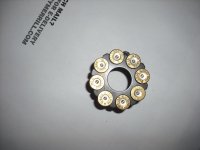jmclfrsh
Member
I recently got back into reloading after a layoff of firearms for 33 years.
I purchased Federal primers for my first batch of reloads, and even with 850-1000 FPS reduced loads, the primers seem flattened as much as 90% FMJ loads.
They also seem flatter than the primers I used in the past, which were CCI probably.
I look at fired primer flattening to indicate higher pressures than I like. Knowing even reduced loads make the Federal primers indicate a higher pressure that they have to be operating under, I have come to the conclusion that the Federal primers (being reportedly softer than others) just indicate higher pressure than other primers do, like Winchester or CCI.
A false reading, if you will.
They are not completely flattened, just more so than normal it seems. Is that a common occurrence with Federal primers?
If so, I may just use the remainder of these 1000 for my reduced loads, and get some CCI primers to help me better judge when I am reaching higher pressures with faster loads.
Thoughts? And thank you for your responses.
I purchased Federal primers for my first batch of reloads, and even with 850-1000 FPS reduced loads, the primers seem flattened as much as 90% FMJ loads.
They also seem flatter than the primers I used in the past, which were CCI probably.
I look at fired primer flattening to indicate higher pressures than I like. Knowing even reduced loads make the Federal primers indicate a higher pressure that they have to be operating under, I have come to the conclusion that the Federal primers (being reportedly softer than others) just indicate higher pressure than other primers do, like Winchester or CCI.
A false reading, if you will.
They are not completely flattened, just more so than normal it seems. Is that a common occurrence with Federal primers?
If so, I may just use the remainder of these 1000 for my reduced loads, and get some CCI primers to help me better judge when I am reaching higher pressures with faster loads.
Thoughts? And thank you for your responses.
Last edited:


